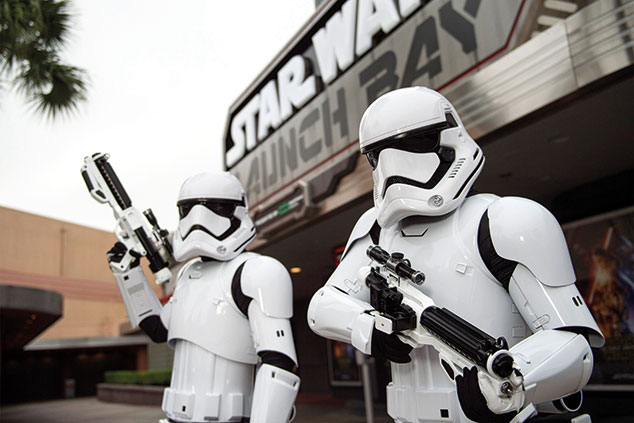
Walt Disney (NYSE: DIS) is embarking on a pivotal year. It has just completed its $71bn takeover of 21st Century Fox. It expects more box-office blockbusters, while the first-ever Star Wars theme park attractions should draw big crowds. Most importantly, it will make a big push into streaming: delivering entertainment (“content”) to computers and televisions directly over the internet, thus challenging the likes of Netflix.
Catching up with Netflix
One reason it has seen lacklustre returns is that Disney hasn’t yet embraced streaming, so investors seeking out fast-growing sectors have overlooked it. Although its theme parks and movie studios are growing, its Media Networks business, which encompasses its television, cable, radio and publishing assets, has stagnated as viewers have ditched cable TV for online streaming offerings such as Netflix and Amazon Prime.
By building a strong streaming presence through its new Direct-to-Consumer business, Disney intends to rectify this. Its new offering, Disney+, will give subscribers direct access to the formidable library of the Disney/21st Century Fox movies and TV shows as well as Star Wars, Marvel, Pixar and National Geographic content. This material will gradually disappear from the offerings of other streaming services, which have hitherto been showing Disney content under a licensing agreement with the entertainment giant. The streamers will find life tougher as the deep-pocketed “old guard” media companies enter the sector themselves, fragmenting audiences and forcing incumbents to produce even more original content while the quality bar and costs rise.
Disney’s odds in this context are favourable. It has first-class content and sufficient experience, particularly as it owns 60% of Hulu, a popular streaming service with 23 million users. It has know-how, as the owner of most of BAMTech, a streaming video technology leader. And it has the tried-and-tested imagination to build an offering around what its audiences want, whether that be new films, shows, tie-ins or interactive programming (whereby people can influence the content onscreen). Perhaps Disney’s biggest asset, however, is its powerful brand, which is deeply embedded in global popular culture.
In turn, Disney gets what helped make Netflix a winner: detailed user data, the holy grail of modern marketing and sales. With access to viewing habits and preferences, it can produce bespoke offerings and suggestions for subscribers, building loyalty. It will also have valuable data for marketing, advertising and new content origination.
A promising trial run
For now, it’s early days. The prices offered by Disney+ haven’t even been announced, although they are likely to undercut Netflix. However, Disney moved its sports channel ESPN to streaming last year. Even though it doesn’t offer the premium content of the existing ESPN channel, it went from zero to one million paying subscribers in its first five months last year. It took streaming services DirecTV Now and CBS All Access a year and nearly two years respectively to reach this figure.
Given the outlook, Disney appears under-appreciated. The shares are 10% cheaper than the overall market and trading 25% below their longer-term valuation range. With strong management, profitable businesses and a well-managed balance sheet, even in its present form Disney is worth tucking away as a high-quality value stock. The potential bonus comes from a reappraisal of its value as investors begin to factor in new growth driven by streaming.
Kicking the tyres… a $161bn behemoth
With headquarters in California and a 95-year history, Walt Disney is among the world’s leading media businesses. It’s a horizontally integrated group, meaning it operates end-to-end across its sector.
It writes and draws new projects; films, produces and distributes them; operates TV and radio broadcasters (including ABC, the national US TV network), cable companies and publishers; builds and runs theme parks comprising attractions, dining and accommodation; offers a themed cruise holiday fleet; and sells related merchandise and licenses its brands to third parties.
Disney’s market value is more than $161bn, and it generated revenues last year of more than $59bn, an 8% year-on-year rise. The biggest contribution came from Media Networks at $21.9bn, followed closely by Theme Parks, Experiences and Consumer Products with $24.7bn. Studio Entertainment – the motion picture business – added another $10.1bn with the rest from Direct-to-Consumer and international operations, with $3.4bn. Net income rose by 40% to around $12.6bn with earnings per share of $7.08.
Management is led by Bob Iger who first joined the ABC TV subsidiary in 1974. he has had a long career and a successor is expected to be announced in the not-too-distant future. The shares are trading on a price/earnings ratio of 15, and the stock has an annual dividend yield of about 1.6%. As the acquisition of 21st Century Fox beds in and further streaming news is released, forecasts are likely to be refined. For now, at least 20 analysts cover the company, with most deeming the stock “buy” or “strong buy”. The next announcement, on Tuesday 5 February, will feature first-quarter earnings. Disney+ will be unveiled for the first time at the Disney Investor Day on 11 April.